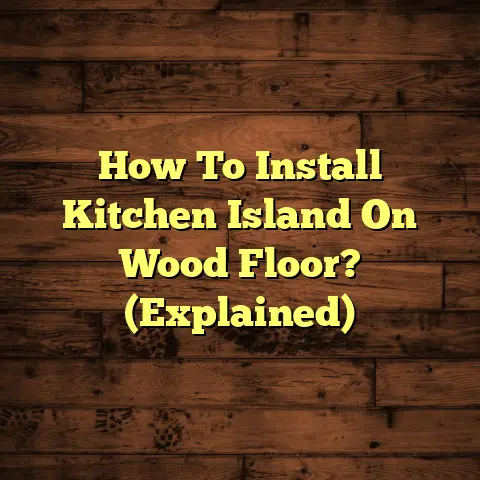Hardwood Floor Squeaks: Causes & Fixes? (3 Top Tips)
Why did the floor get a promotion?
Because it always knew how to handle
squeaky situations!
(Okay, okay, I know, cheesy, but hey, it got your attention, right?)
Hardwood floors are beautiful, timeless,
and add a ton of value to a home.
But, let’s be honest, that symphony of
creaks and groans?
Not so charming.
I’ve spent years as a flooring contractor,
and I can tell you, squeaky floors are
one of the most common complaints I hear.
It’s a problem that can drive you nuts.
But don’t worry!
I’m going to break down
exactly why your hardwood floors are
serenading you with unwanted noise.
More importantly, I’m going to give you my top 3 tips for fixing those squeaks and restoring peace and quiet to your home.
Section 1: Understanding Hardwood Floor Squeaks
So, what exactly is a hardwood floor squeak?
It’s that annoying sound – a creak, groan,
or squeal – that happens when you walk
across your hardwood floor.
These noises can manifest in a few ways.
Sometimes, it’s a periodic squeak in a
specific spot.
Other times, it’s a
continuous creaking sound throughout a room.
No matter how it sounds, it’s usually
caused by friction.
Something is rubbing
against something else under your feet.
And believe me, squeaks are incredibly common.
In my experience, almost every hardwood
floor will develop a squeak or two
eventually, especially in older homes.
Why are they such a concern?
Well,
besides being irritating, squeaks can
indicate underlying issues with your floor.
They might signal loose floorboards,
a problem with the subfloor, or even
moisture damage.
Addressing squeaks
isn’t just about silencing the noise.
It’s about protecting the integrity and longevity of your beautiful hardwood floors.
Section 2: Common Causes of Hardwood Floor Squeaks
Let’s get into the nitty-gritty.
What’s actually causing those annoying squeaks?
Here are the most common culprits I’ve seen over
the years, broken down for easy understanding:
Subsection 2.1: Expansion and Contraction
Wood is a natural material, and it’s
constantly reacting to its environment.
Changes in humidity and temperature cause
wood to expand and contract.
Think about it: in the humid summer months, your hardwood floors will absorb moisture from the air and expand slightly.
In the dry winter months, they’ll lose
moisture and contract.
This constant
movement can cause the floorboards to rub
against each other or against the subfloor.
And that rubbing?
That’s where your squeaks come from.
According to the National Wood Flooring Association
(NWFA), maintaining consistent humidity levels
(between 30-50%) is crucial for preventing
excessive expansion and contraction.
I’ve seen homes where simply installing a humidifier during the winter drastically reduced floor squeaks.
Subsection 2.2: Loose Floorboards
This is probably the most common cause of
hardwood floor squeaks I encounter.
Over time, the nails, screws, or adhesive
holding your floorboards in place can loosen.
Think about it: every time you walk across
your floor, you’re putting stress on those
fasteners.
Eventually, they can start to give way.
When a floorboard becomes loose, it can shift
and move slightly when you walk on it.
This movement creates friction against
adjacent boards or the subfloor, leading to squeaks.
Sometimes, it’s just a single nail that’s popped
up.
Other times, it’s a larger area where
the adhesive has failed.
Either way, loose
floorboards are a prime squeak offender.
Subsection 2.3: Inadequate Underlayment
Underlayment is a layer of material installed
between the subfloor and the hardwood flooring.
It provides cushioning, sound insulation, and
moisture protection.
If your hardwood floor was installed without proper underlayment, or if the underlayment is old and compressed, it can exacerbate noise issues.
Without sufficient cushioning, the hardwood floorboards are more likely to rub directly against the subfloor, creating squeaks and other noises.
I’ve even seen cases where the wrong type of
underlayment was used, such as a thin foam
that didn’t provide enough support.
This is especially common in older homes
where underlayment wasn’t always standard practice.
Subsection 2.4: Subfloor Issues
The subfloor is the foundation upon which
your hardwood floor is installed.
If the subfloor is uneven, damaged, or
inadequate, it can contribute to squeaking.
An uneven subfloor can create gaps between
the hardwood flooring and the subfloor.
When you step on a floorboard over a gap,
it can flex and rub against the subfloor, causing a squeak.
Similarly, a damaged subfloor, such as one with rot or water damage, can be unstable and unable to properly support the hardwood flooring.
I’ve seen situations where the subfloor was
simply too thin for the span of the floor joists.
This caused the entire floor to flex and
squeak whenever someone walked across it.
In these cases, addressing the subfloor issue is crucial for eliminating the squeaks.
Section 3: Fixing Hardwood Floor Squeaks
Alright, now for the good stuff!
Let’s talk about how to actually fix
those annoying hardwood floor squeaks.
I’m going to share my top 3 tips, based
on years of experience dealing with this
very problem.
Each tip comes with detailed
explanations and step-by-step instructions.
Tip 1: Tightening Loose Floorboards Tip 2: Adding Lubrication Tip 3: Installing a New Underlayment
Tip 1: Tightening Loose Floorboards
As I mentioned earlier, loose floorboards
are a major cause of squeaks.
So,
tightening them up is often the first step
in silencing your noisy floors.
How to Identify Loose Floorboards:
The easiest way is to simply walk around
the room and listen for squeaks.
Once you find a squeaky spot, press down
on the floorboard to see if it moves or flexes.
You can also use a rubber mallet to gently
tap on the floorboards.
Loose boards will
often sound hollow or produce a rattling sound.
Methods for Tightening Loose Floorboards:
Screws: This is my preferred method for tightening loose floorboards, especially if you have access to the joists from below (e.g., in a basement).
-
Tools Needed:
- Drill with screw gun attachment
- Wood screws (1 1/4″ to 1 5/8″ are usually sufficient)
- Countersink bit
- Wood filler (optional)
- Sandpaper (optional)
-
Step-by-Step Instructions:
-
Locate the Joist: Use a stud finder or tap along the floor to find the joist beneath the loose floorboard.
-
Pre-drill a Pilot Hole: Using a drill bit slightly smaller than the diameter of your screw, pre-drill a pilot hole through the floorboard and into the joist.
This will prevent the wood from splitting. -
Countersink the Hole: Use a countersink bit to create a recess for the screw head.
This will allow the screw head to sit flush with the surface of the floor. -
Drive in the Screw: Use a screw gun to drive the screw into the pilot hole.
Be careful not to over-tighten the screw, as this can damage the wood. -
(Optional) Fill the Hole: If you want to conceal the screw head, you can fill the countersunk hole with wood filler.
Allow the filler to dry completely, then sand it smooth with fine-grit sandpaper.
-
-
Nails: Nailing is another option, but I find screws to be more secure in the long run.
-
Tools Needed:
- Hammer
- Finishing nails (1 1/2″ to 2″ are usually sufficient)
- Nail set
- Wood filler (optional)
- Sandpaper (optional)
-
Step-by-Step Instructions:
-
Position the Nail: Place the nail at a slight angle into the loose floorboard, aiming towards the joist.
-
Hammer in the Nail: Use a hammer to drive the nail into the floorboard.
-
Set the Nail: Use a nail set to drive the nail head slightly below the surface of the wood.
This will prevent the nail head from being visible. -
(Optional) Fill the Hole: If you want to conceal the nail head, you can fill the hole with wood filler.
Allow the filler to dry completely, then sand it smooth with fine-grit sandpaper.
-
-
Construction Adhesive: This is a good option if you don’t have access to the joists from below or if you’re dealing with a larger area of loose flooring.
-
Tools Needed:
- Construction adhesive
- Caulking gun
- Weight (e.g., books, bricks)
- Damp cloth
-
Step-by-Step Instructions:
-
Clean the Area: Clean the area around the loose floorboard with a damp cloth to remove any dirt or debris.
-
Apply Adhesive: Apply a bead of construction adhesive to the underside of the loose floorboard.
You may need to use a putty knife to lift the edge of the floorboard slightly to apply the adhesive. -
Press Down Firmly: Press the floorboard down firmly onto the subfloor.
-
Weight the Area: Place a weight on top of the floorboard to hold it in place while the adhesive dries.
-
Allow to Dry: Allow the adhesive to dry completely according to the manufacturer’s instructions.
-
-
Safety Precautions:
- Always wear safety glasses when drilling or hammering.
- Be careful not to damage any electrical wiring or plumbing when drilling into the floor.
- If you’re not comfortable working with tools, consider hiring a professional flooring contractor.
Tips for Achieving a Clean Finish:
- Use a countersink bit to create a recess for the screw head.
- Use wood filler to conceal screw or nail holes.
- Sand the wood filler smooth with fine-grit sandpaper.
- Apply a matching stain or finish to the filled areas to blend them in with the surrounding floor.
Tip 2: Adding Lubrication
Sometimes, even if the floorboards are
secure, they can still squeak due to friction.
In these cases, adding lubrication can help
reduce the friction and silence the squeaks.
Types of Lubricants:
Talcum Powder: This is a classic remedy for squeaky floors.
Talcum powder is a fine powder that can help reduce friction between floorboards.Graphite Powder: Graphite powder is another excellent lubricant.
It’s especially effective for lubricating tongue-and-groove joints.Specialized Wood Lubricants: There are also several specialized wood lubricants available on the market.
These lubricants are designed to penetrate the wood and reduce friction without damaging the finish.
Step-by-Step Process for Applying Lubricant:
-
Identify the Squeaky Area: Walk around the room and identify the exact location of the squeak.
Apply the Lubricant:
-
Talcum Powder: Sprinkle a small amount of talcum powder over the squeaky area.
Use a soft brush or cloth to work the powder into the gaps between the floorboards. -
Graphite Powder: Apply a small amount of graphite powder to the gaps between the floorboards.
You can use a small brush or a squeeze bottle to apply the powder. -
Specialized Wood Lubricants: Apply the lubricant according to the manufacturer’s instructions.
-
-
Work the Lubricant In: Walk over the squeaky area several times to work the lubricant into the gaps between the floorboards.
-
Wipe Away Excess: Use a damp cloth to wipe away any excess lubricant from the surface of the floor.
Tips for Effective Results:
- Use a small amount of lubricant at first, and add more as needed.
- Be careful not to get lubricant on the finish of the floor.
- If the squeak persists, try a different type of lubricant.
Tip 3: Installing a New Underlayment
If tightening loose floorboards and adding lubrication don’t solve the problem, it may be necessary to install or replace the underlayment.
This is a more involved process, but it can be very effective for minimizing squeaks, especially if the existing underlayment is old, compressed, or inadequate.
When is it Necessary to Install or Replace the Underlayment?
- If the existing underlayment is old and compressed.
- If the existing underlayment is the wrong type for your hardwood flooring.
- If the subfloor is uneven or damaged.
- If you’re installing new hardwood flooring.
Selecting the Right Type of Underlayment:
There are several different types of
underlayment available, each with its own
advantages and disadvantages.
The best type
of underlayment for your hardwood floor will
depend on your specific needs and budget.
-
Felt Underlayment: Felt underlayment is a traditional type of underlayment that provides good cushioning and sound insulation.
Foam Underlayment: Foam underlayment is a popular choice for hardwood floors.
It’s relatively inexpensive and provides good cushioning and sound insulation.-
Cork Underlayment: Cork underlayment is a natural and sustainable option that provides excellent cushioning, sound insulation, and moisture resistance.
-
Rubber Underlayment: Rubber underlayment is a durable and long-lasting option that provides excellent cushioning, sound insulation, and moisture resistance.
Installation Process:
This is a general overview.
Always follow the
manufacturer’s instructions for your specific
underlayment product.
I always recommend hiring a professional,
especially if you’re not comfortable
with this type of project.
Remove the Existing Flooring: Carefully remove the existing hardwood flooring.
Be sure to label each board so you can reinstall it in the same order.Prepare the Subfloor: Clean the subfloor thoroughly to remove any dirt, debris, or old adhesive.
Repair any damage to the subfloor, such as cracks or holes.Install the Underlayment: Roll out the underlayment over the subfloor, following the manufacturer’s instructions.
Overlap the edges of the underlayment and tape them together with seam tape.-
Reinstall the Hardwood Flooring: Carefully reinstall the hardwood flooring, following the same pattern as before.
Tools and Materials Needed:
- Underlayment
- Seam tape
- Utility knife
- Measuring tape
- Hammer or nail gun
- Hardwood flooring
Section 4: Preventative Measures
Okay, you’ve fixed the squeaks!
Now, how do you prevent them from coming back?
Here are a few preventative measures I recommend:
Regular Maintenance: Sweep or vacuum your hardwood floors regularly to remove dirt and debris.
Clean spills immediately to prevent moisture damage.-
Proper Humidity Levels: Maintain consistent humidity levels in your home (between 30-50%) to prevent excessive expansion and contraction of the wood.
-
High-Quality Materials: When installing new hardwood flooring, choose high-quality materials, including the flooring itself, the underlayment, and the fasteners.
Conclusion
So, there you have it!
A comprehensive guide to understanding and
fixing hardwood floor squeaks.
Remember, squeaks are usually caused by friction, and the most common culprits are loose floorboards, inadequate underlayment, and subfloor issues.
By following my top 3 tips – tightening loose floorboards, adding lubrication, and installing a new underlayment – you can effectively silence those annoying squeaks and restore peace and quiet to your home.
And don’t forget to take proactive steps
to maintain your hardwood floors and
prevent future squeaks.
A little bit of
preventative maintenance can go a long way
in keeping your floors looking and sounding
their best for years to come.
Now go forth and conquer those squeaks!
Your ears (and your sanity) will thank you.





